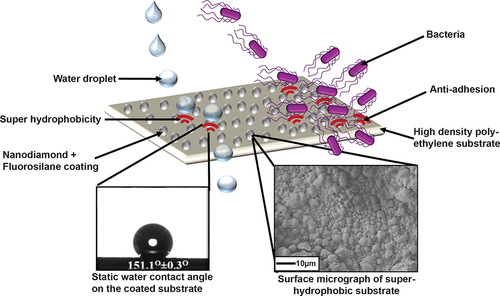当前位置:
X-MOL 学术
›
ACS Food Sci. Technol.
›
论文详情
Our official English website, www.x-mol.net, welcomes your feedback! (Note: you will need to create a separate account there.)
Fabrication of Robust Superhydrophobic Coatings onto High-Density Polyethylene Food Contact Surfaces for Enhanced Microbiological Food Safety
ACS Food Science & Technology Pub Date : 2021-07-14 , DOI: 10.1021/acsfoodscitech.1c00082 Yashwanth Arcot 1 , Shuhao Liu 2 , Beril Ulugun 3 , William DeFlorio 2 , Michael Bae 2 , Karla Solis Salazar 4 , Thomas Matthew Taylor 5 , Alejandro Castillo 4 , Luis Cisneros-Zevallos 4, 6 , Ethan M. A. Scholar 1, 2
ACS Food Science & Technology Pub Date : 2021-07-14 , DOI: 10.1021/acsfoodscitech.1c00082 Yashwanth Arcot 1 , Shuhao Liu 2 , Beril Ulugun 3 , William DeFlorio 2 , Michael Bae 2 , Karla Solis Salazar 4 , Thomas Matthew Taylor 5 , Alejandro Castillo 4 , Luis Cisneros-Zevallos 4, 6 , Ethan M. A. Scholar 1, 2
Affiliation

|
Lack of maintenance and poor sanitation of food-contact surfaces (FCSs) can result in foodborne microbial contamination and biofilm formation. With increasing industrial concerns over food safety and hygiene, it is important to keep FCSs bacteria-free to protect the consumers from various foodborne illnesses. In the current study, we report the fabrication of highly durable nanodiamond (ND) based coatings on high-density polyethylene (HDPE), combining the chemisorption of low surface energy ligands and rigid nanotexturing. The coated HDPE surfaces resulted in static, advancing, and receding water contact angles of 151.1 ± 0.3°, 155.0 ± 1.0°, and 151.0 ± 1.9°, respectively. This superhydrophobic coating demonstrated excellent mechanical durability, retaining its highly water-repellent nature after surface abrasion with spinach leaves and onion peels, as well as after 50 cycles of sand abrasion. In comparison to bare HDPE, the adhesion of Salmonella typhimurium LT2 and Listeria innocua bacteria onto the coated surfaces was reduced by 2.1 ± 0.43 (>99.34%) and 1.6 ± 0.55 (>97.75%) log-cycles, respectively. In addition, the coated substrates successfully reduced the cross-contamination of spinach leaves by S.typhimurium LT2 and L. innocua. Overall, this study demonstrates the proof-of-concept that durable superhydrophobic coatings involving nanodiamond on HDPE have the potential to reduce bacterial cross-contamination scenarios of FCSs in food processing environments.
中文翻译:

在高密度聚乙烯食品接触表面上制造坚固的超疏水涂层以增强微生物食品安全
食品接触表面 (FCS) 缺乏维护和卫生条件差会导致食源性微生物污染和生物膜形成。随着业界对食品安全和卫生的日益关注,保持 FCS 无菌以保护消费者免受各种食源性疾病的侵害非常重要。在目前的研究中,我们报告了在高密度聚乙烯 (HDPE) 上制造高度耐用的纳米金刚石 (ND) 涂层,结合低表面能配体的化学吸附和刚性纳米纹理。涂覆的 HDPE 表面导致静态、前进和后退水接触角分别为 151.1 ± 0.3°、155.0 ± 1.0° 和 151.0 ± 1.9°。这种超疏水涂层表现出优异的机械耐久性,在用菠菜叶和洋葱皮进行表面磨损以及经过 50 次砂磨循环后,仍保持其高度防水的特性。与裸 HDPE 相比,涂覆表面上的鼠伤寒沙门氏菌LT2 和无害李斯特菌分别减少了 2.1 ± 0.43 (> 99.34%) 和 1.6 ± 0.55 (> 97.75%) 对数周期。此外,涂层基材成功地减少了S. typhimurium LT2 和L. innocua对菠菜叶的交叉污染。总体而言,这项研究证明了概念验证,即 HDPE 上包含纳米金刚石的耐用超疏水涂层有可能减少食品加工环境中 FCS 的细菌交叉污染情况。
更新日期:2021-08-20
中文翻译:

在高密度聚乙烯食品接触表面上制造坚固的超疏水涂层以增强微生物食品安全
食品接触表面 (FCS) 缺乏维护和卫生条件差会导致食源性微生物污染和生物膜形成。随着业界对食品安全和卫生的日益关注,保持 FCS 无菌以保护消费者免受各种食源性疾病的侵害非常重要。在目前的研究中,我们报告了在高密度聚乙烯 (HDPE) 上制造高度耐用的纳米金刚石 (ND) 涂层,结合低表面能配体的化学吸附和刚性纳米纹理。涂覆的 HDPE 表面导致静态、前进和后退水接触角分别为 151.1 ± 0.3°、155.0 ± 1.0° 和 151.0 ± 1.9°。这种超疏水涂层表现出优异的机械耐久性,在用菠菜叶和洋葱皮进行表面磨损以及经过 50 次砂磨循环后,仍保持其高度防水的特性。与裸 HDPE 相比,涂覆表面上的鼠伤寒沙门氏菌LT2 和无害李斯特菌分别减少了 2.1 ± 0.43 (> 99.34%) 和 1.6 ± 0.55 (> 97.75%) 对数周期。此外,涂层基材成功地减少了S. typhimurium LT2 和L. innocua对菠菜叶的交叉污染。总体而言,这项研究证明了概念验证,即 HDPE 上包含纳米金刚石的耐用超疏水涂层有可能减少食品加工环境中 FCS 的细菌交叉污染情况。


























 京公网安备 11010802027423号
京公网安备 11010802027423号